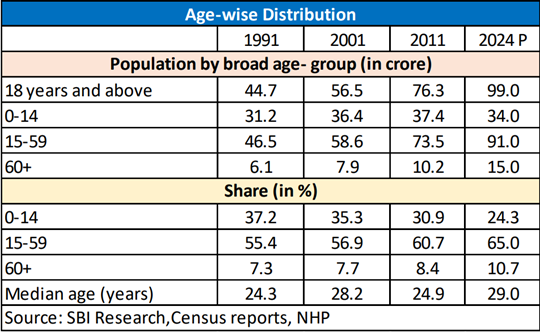PREVIOUS
SBI ERD report 2024
October 4 , 2024
51 days
210
0
- SBI’s economic research department (ERD) released a new report, “Precursor to Census 2024: The Fine Prints of a Rapidly Changing Nation.”
- The average annual exponential growth of India is expected to decline from 2.20 per cent in 1971 to 1 per cent in 2024.
- The national population will be in the range of 138-142 crore in 2024.
- The median age of India is expected to increase from 24 years in 2021 to 28-29 years in 2023/24.
- The working age population (15-59) is likely to increase to 65.2 per cent in the 2031 census.
- The elderly population will cross 15 crores (Female: 7.7 crore; Male: 7.3 crore), with a growth of 4.6 crore during 2011-2024.
- Southern States, chiefly Tamil Nadu, Andhra Pradesh, and Telangana, in incremental population growth is set to decline (vis-à-vis 2011).
- Northern States, led by UP and Bihar (with a 33 per cent share in incremental growth), will drive the growth.
- The northern and eastern regions together are expected to have a 52 per cent share of the entire population (51 per cent in 2011).
- Apart from the Union Territories, Goa and Kerala are highly urbanised.
- Among the major states, Tamil Nadu continues to be the most urbanised State, with 54 per cent of the population living in urban areas, followed by Maharashtra (48.8 per cent).
- Himachal Pradesh (10.3 per cent), followed by Bihar (12.4 per cent), Assam (15.7 per cent), and Orissa (19.0%) form the bottom end of the spectrum.

Leave a Reply
Your Comment is awaiting moderation.


